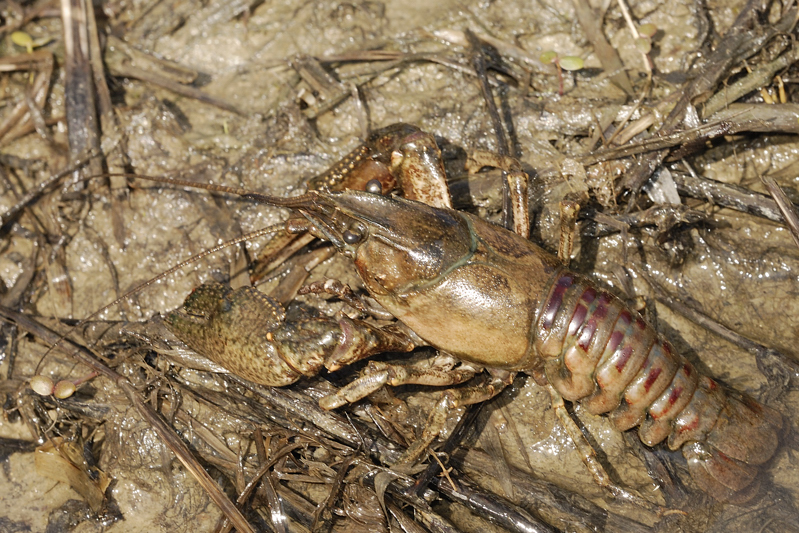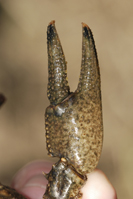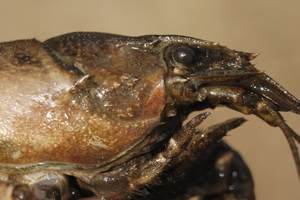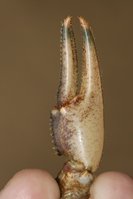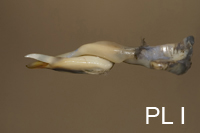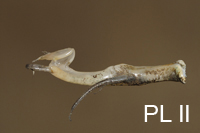|
||||
|
Faxonius limosus (Rafinesque 1817) |
|
|||
|
General description. Distribution |
||||
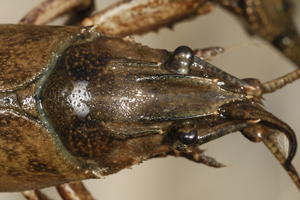
Suppler medium size crayfish, the
adults having between 6 and 12 cm long. The colour of the crust goes
from brown olive to light brown to dark brown, sometimes blue brown.
Usually one may distinguish red brown strips on the abdomen segments
and on the pleura. The claws are smooth with lighter ventral part
and orange top black rounded, visible on the ventral side. The
rostrum is long with parallel margins ended with spines. The apex is
long and sharp. Postorbital there is a single long ridge that ends
with a spine. The cephalothorax is smooth with several spines on the
sides of the cervical groove and cephalic region. and the
dactilopodit with a median tubercle.
There is a prominent and
curved spine
on the internal margin of
the carpus. There is a
robust spine
on
the ventral part of |
||||
|
Sexual dimorphism |
||||
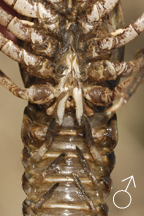 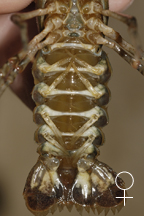
The claws isn't a relevant information to determine the
sexes. In order to precisely distinguish the males from the females
one may verify the pleopodes. Male crayfish have the first two pairs
of
pleopodes strong and oriented towards the front (for the transfer of
the spermatophores)
while the female has all the
pleopodes equal. The shape of the first two males |
||||
|
Habitat and Ecology |
||||
| It prefers to live in muddy and turbid waters from the plains, large rivers, canals, lakes or ponds. In North America it was found even in current streams that have rocks on the bottom. In Europe it is present almost everywhere including cold and fast waters but preferring deep and cool waters, being frequent in ponds and lakes. It is active day and night eating almost every kind of food. The adults frequently eat vegetal food. It is very resistant to low concentration of oxygen or to bad quality of the water that helps him in the invasion process. It can successfully resist even several days without water. The natural enemies are the otter, the muskrat, the rats, the mink, the nutria, the fox, the badger and water birds- for the adults, the fishes being a real threat for the juveniles; the sheatfish, the pike, the perch and the sturgeons being the larger consumers. It is very resistant to parasitical diseases and to Aphanomyces astaci fungus to which it has antibodies. Ectoparasitism, without producing any damage, is frequently found at the branhiobdelides, chironomides, ostracodes species and others. Bivalves colonies can often be attached on the adults (Dreissena sp.). | ||||
|
Life history |
||||
| A great advantage compared to indigenous crayfish species is that of the great reproductive capacity of this species. The spiny-cheek crayfish copulates in autumn and spring and even during winter, when the females have white spermatophores on the sternal plate.. The laying contains a big number of eggs (around 400) and it is carried by the female between the pleopodes until the juveniles become independent. The growing speed is also very favourable, in 6 or 7 weeks the juveniles can become independent. The age is determined taking into consideration the total length as following 0+ 18-30 mm; 1+ 40-65 mm; 2+ 65-80 mm; 3+ 80-95 mm; 4+ 95-110 mm. The molting is more frequent to young ages (up to 4 to 5 periods per year) while at the adults the molt happens once or twice a year, usually during spring or summer. The next couple of days after molting are very critical for the crayfish. Because it loses the protection of the crust and can be easily attacked by fishes or even by other crayfish that have stronger crust. After this period the lost or hurt appendix can regenerate but usually a broken claw grows up smaller. The spiny-cheek crayfish become sexual active after its first year of life, at a total length of almost 50-65 mm. | ||||
|
Selective bibliography |
||||
|
1. Holdich DM, Haffner
P, NoŰl PY (2006)
Species files
in
Souty-Grosset, C., Holdich, D. M.,
NoŰl, P. Y., Reynolds, J. D., Haffner, P. (Eds.), Atlas of Crayfish
in Europe. MusÚum national d’Histoire naturelle, Paris (Patrimoines
naturels, 64); 3. PÔrvulescu L, Paloș C, Molnar P (2009) First record of the spiny-cheek crayfish Orconectes limosus (Rafinesque, 1817) (Crustacea: Decapoda: Cambaridae) in Romania. North-Western Journal of Zoology 5(2); 4. PÔrvulescu L (2010) Crayfish field guide of Romania. Editura Bioflux, Cluj-Napoca. |
||||
